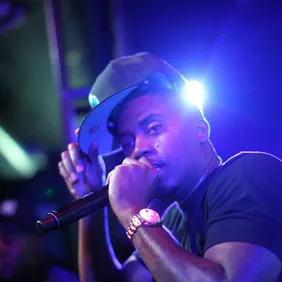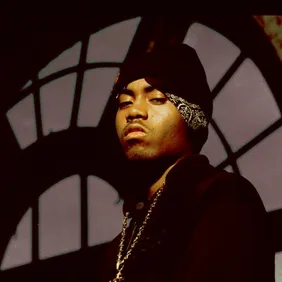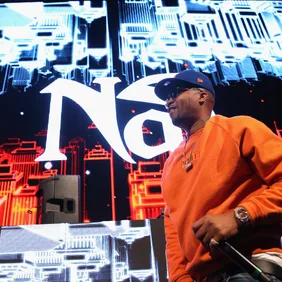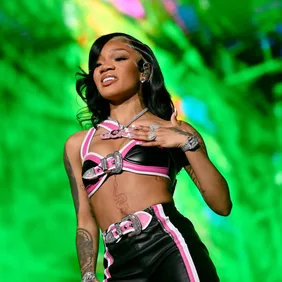For many self-styled hip-hop heads, Illmatic is equivalent to Citizen Kane in legacy alone. Those new to the genre are often referred to Nas’ debut as a homework assignment of sorts. The mere idea that it was penned by a nineteen-year-old serves as an undeniable benchmark for rappers aspirant. Such is the story of Illmatic, revered to the point of parody; are you truly among the cultural elite if you don’t place it comfortably within your top five? Considering the fact he ultimately managed to live up to his own lofty expectations, Nas’ slog from journeyman observer to storied legend was equally hard fought and well-deserved.
Those privy to the come-up could tell that something special was unfolding. A clip from the documentary Time Is Illmatic revealed a baby-faced Nas fighting to impress during an open mic, in which he promised to aim “guns at nuns,” much to the crowd’s delight. Such unrelenting bars were unprecedented in a still-developing musical identity, and Nas imminently shot to the top of the draft charts. After came the dawn of one of hip-hop’s long-standing careers, which recently culminated in an eleventh studio album, eponymous at that. Therefore, it felt right to bookend this review with a little piece of history, as Nas’ storied past is carried within him, like the cross he once proudly bore on God’s Son.
In that regard, Nas’ status as a legacy artist makes it difficult to examine his work in a vacuum. Such is absolutely true of Nasir, which arrives at a time when the game’s appreciation for lyricism has sadly waned. Red plastic double-cups now litter the lawns Nas may or may not tell wayward children to get off of. Consider the length of his six-year absence, in which he slid behind the curtain, turning in the mic in favor of a burgeoning business portfolio. Yet loyalists never doubted the validity Nas’ inevitable return; though he may feel displaced in a (de)evolving game, his presence at the table has been forever entrenched above the mantle.
Can something at once be considered spectacle and anticlimactic? Consider the inclusion of Nasir in Yeezy’s G.O.O.D Music pentalogy, sandwiched between Kids See Ghosts and Teyana Taylor’s still untitled project. The mere idea that Kanye West would be handling production on a Nas album seemed to ignite passion in both fanbases, who no doubt secretly longed for a return to the College Dropout days. In truth, given the musical adventurism of Ye’s recent endeavors, it became difficult to gauge the barometer. Yet, perhaps appropriately given the intended recipient, Kanye’s beats are conservative by his own standards.
Don’t get it twisted. That’s by and large a positive, as Nas tends to falter over a more grandiose canvas. Consider album opener “Not For Radio,” which seems to deliberately evoke shades of “Hate Me Now,” right down to the Diddy feature. As a reintroduction to Nas, the song seems to be presenting a checklist of sorts. Cinematic, Gregorian-chant driven instrumental, check. Politically-charged conspiratorial rhetoric, check. Yet somehow, it all feels phoned-in, missing some of the drive present on peak Nas material. Compared to a personal favorite, God’s Son opener “Get Down,” “Not For Radio” sounds undeniably watered down. Though he has long earned the right to let his impressive gravitas dictate his pace, the idea of a mogul-talk driven Nas feels somehow wrong.
Luckily, the project takes an exciting turn on “Cops Shot The Kid,” a beat that might be obnoxious if it weren’t so infectious. Tackling the oft-discussed topic of police brutality over a relentless Slick Rick refrain, Nas paints yet another impressive narrative, though perhaps lacking some of his initial refinement. "White kids are brought in alive, black kids get hit with like five,” raps Nas, with a singsong flow befitting of the sample’s author. “Get scared, you panic, you're goin' down, the disadvantages of the brown.” The significance of the message is driven home by the chorus, in which a somber synth progression imbues the song with a welcome aura of melancholy.
As the journey progresses, the narrative opens up to find Nas in full-fledged boss mode, one Basquiat short of a Jay-Z feature. Given his penchant for clever investments, one can hardly fault Nas for indulging in a little grown man flex-rap. Such is indeed the case on “Bonjour,” which finds Nasir channeling his inner “voulez vous coucher avec moi,” detailing the benefits of adding palenta to one’s diet while doling out gems like an OG wisdom dispensary. Is this what we came for? Hard to say, given the extended absence; in truth, it’s nice to once again hear Esco grace the microphone. For that reason, the more candy-coated moments still prove satisfactory, if somewhat shallow.
The album ultimately reaches its most rewarding stages during the final act, which kicks off with the multi-pronged, near eight minute epic “everything.” After an extended introduction from Kanye West and The-Dream, Nasir returns with shades of fire-long-waned, rapping “death by the chrome barrel, forgot the secrets, my Kilimanjaro bone marrow's the deepest, you can peep at the comments, but don't fall for that, we want freedom, I'm a scholar, an almanac.” The mere fact that Nas actually provides three verses of solid lyrical content make “everything” one of Nasir’s more definitive moments.
Likewise for “Adam and Eve,” arguably the project’s best selection. Kicking off with a reference only Nas would make, likening himself to Shakespearean icon Othello, he proceeds to deliver his best lyricism in nearly a decade. The second verse possesses the poetic sensibilities that served to seperate Mr. Jones from his peers, combining abstract imagery and non-sequiturs with grounded, ghetto truths. “My language advanced, my cadence amazin, the voice triggers somethin', what is this conundrum?” raps Nas. “The clouds scurry, your spirit rumble, a boyish smile, still puff the loud, it's nothin' less than a quarter pound.” Moments of brilliance such as this prove that Nas’ mind works different from his peers.
Unfortunately, the open-ended lyricism of “Adam and Eve” is more exception than rule on Nasir. More often than not, Nas feels content to spoon-feed his listeners, even if the dishes are rich in flavor as spicy rigatoni and red bordeaux. Yet Nas is at his best when he allows listeners space to reach their own conclusions, drawing from the strength of his unparalleled imagination. While moments of that nature do exist on Nasir, the experience is largely defined by the notion that yes, Nas has returned to the fold. Does it stand alongside the heights of his storied catalog? Doubtful. Yet in 2018, the game can still benefit from the teachings of Nasir Jones. One can only hope this was merely the beginning.







